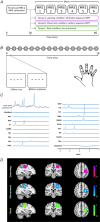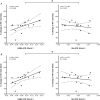The dynamics of cortical GABA in human motor learning
- PMID: 30300446
- PMCID: PMC6312422
- DOI: 10.1113/JP276626
The dynamics of cortical GABA in human motor learning
Abstract
Key points: The ability to learn new motor skills is supported by plasticity in the structural and functional organisation of the primary motor cortex in the human brain. Changes inhibitory to signalling by GABA are thought to be crucial in inducing motor cortex plasticity. This study used magnetic resonance spectroscopy (MRS) to quantify the concentration of GABA in human motor cortex during a period of motor learning, as well as during a period of movement and a period at rest. We report evidence for a reduction in the MRS-measured concentration of GABA specific to learning. Further, the GABA concentration early in the learning task was strongly correlated with the magnitude of subsequent learning: higher GABA concentrations were associated with poorer learning. The results provide initial insight into the neurochemical correlates of cortical plasticity associated with motor learning, specifically relevant in therapeutic efforts to induce cortical plasticity during recovery from stroke.
Abstract: The ability to learn novel motor skills is a central part of our daily lives and can provide a model for rehabilitation after a stroke. However, there are still fundamental gaps in our understanding of the physiological mechanisms that underpin human motor plasticity. The acquisition of new motor skills is dependent on changes in local circuitry within the primary motor cortex (M1). This reorganisation has been hypothesised to be facilitated by a decrease in local inhibition via modulation of the neurotransmitter GABA, but this link has not been conclusively demonstrated in humans. Here, we used 7 T magnetic resonance spectroscopy to investigate the dynamics of GABA concentrations in human M1 during the learning of an explicit, serial reaction time task. We observed a significant reduction in GABA concentration during motor learning that was not seen in an equivalent motor task lacking a learnable sequence, nor during a passive resting task of the same duration. No change in glutamate was observed in any group. Furthermore, M1 GABA measured early in task performance was strongly correlated with the degree of subsequent learning, such that greater inhibition was associated with poorer subsequent learning. This result suggests that higher levels of cortical inhibition may present a barrier that must be surmounted in order to achieve an increase in M1 excitability, and hence encoding of a new motor skill. These results provide strong support for the mechanistic role of GABAergic inhibition in motor plasticity, raising questions regarding the link between population variability in motor learning and GABA metabolism in the brain.
Keywords: GABA; Motor cortex; Plasticity.
© 2018 The Authors. The Journal of Physiology published by John Wiley & Sons Ltd on behalf of The Physiological Society.
Figures




References
-
- Bachtiar V & Stagg CJ (2014). The role of inhibition in human motor cortical plasticity. Neuroscience 278, 93–104. - PubMed
-
- Cabanes E, Confort‐Gouny S, Le Fur Y, Simond G & Cozzone PJ (2001). Optimization of residual water signal removal by HLSVD on simulated short echo time proton MR spectra of the human brain. J Magn Reson 150, 116–125. - PubMed
Publication types
MeSH terms
Substances
Grants and funding
LinkOut - more resources
Full Text Sources

